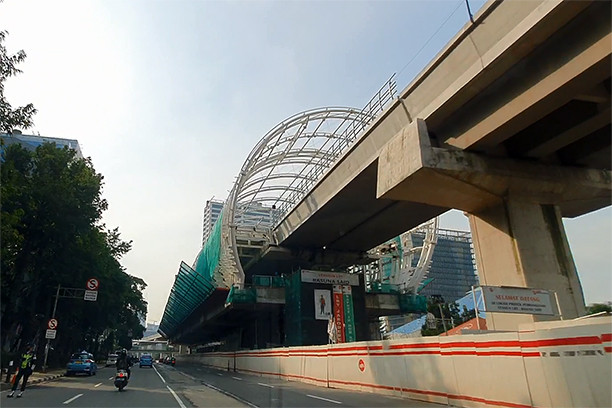Popular Reads
Top Results
Can't find what you're looking for?
View all search resultsPopular Reads
Top Results
Can't find what you're looking for?
View all search resultsPlanned LRT Jakarta route change meets resistance
The city submitted a proposal to reroute the line to Velodrome-Halim in September. The proposed route appears to have stops in Klender, Pondok Bambu and Halim, all in East Jakarta.
Change text size
Gift Premium Articles
to Anyone
T
he Jakarta administration is planning to alter the route of its first light rail transit (LRT) corridor, as city councilors, who were left out of the discussions, raise concerns that the decision was too hasty.
The corridor will stretch from Kelapa Gading in North Jakarta to Dukuh Atas in Central Jakarta, in accordance with the 2018 to 2019 Greater Jakarta Transportation Master Plan established by Presidential Regulation No. 55/2018.
The first section of the route, which connects Kelapa Gading and the Jakarta International Velodrome in Rawamangun, East Jakarta, officially commenced operations on Dec. 1, 2019.
Since then, the city administration has been preparing for the expansion of the line from Velodrome to Manggarai in South Jakarta.
However, the city submitted a proposal to reroute the line to Velodrome-Halim in September. The proposed route appears to have stops in Klender, Pondok Bambu and Halim, all in East Jakarta.
Jakarta Transportation Agency head Syafrin Liputo said the proposed route sought to accommodate the government’s plan to develop Manggarai Station into a long-distance railway hub by 2022 and reduce potential crowding and other complexities that came with construction at the station.
“The ministry previously decided that Manggarai Station would be a transport hub for intercity trains. As such, we needed to shift the initial Velodrome-Manggarai route more to the east,” Syafrin told reporters last week.
A major expansion of Manggarai Station is being planned to increase its passenger capacity. The ground floor platforms will serve the Bekasi commuter line and the airport train, while long distance trains and the Bogor commuter line will operate out of the second floor platforms.
Transportation Ministry spokesperson Adita Irawati said the ministry was still deliberating the plan, but some Jakarta city councilors have criticized the proposal.
Jakarta councilor Gilbert Simanjuntak of the Indonesian Democratic Party of Struggle (PDI-P) was disappointed that the administration had not consulted the city’s councilors.
“This is something that should have been discussed with councilors because it is a multiyear project and there are ticket subsidies involved. Any kind of subsidy for the public requires approval from councilors,” he told The Jakarta Post on Friday.
During the deliberation of the 2021 city budget, the city transportation agency proposed a Rp 200 billion (US$14.15 million) allocation for land acquisition for the development of the Jakarta LRT.
Gilbert said the councilors might approve the proposed budget but they still disagreed about the public-private partnership scheme that the administration had requested.
Syafrin said the private sector’s involvement was necessary because of the current constraints on state funding resulting primarily from the COVID-19 pandemic.
A councilor from the recently established Indonesian Solidarity Party (PSI), Eneng Malianasari, expressed similar concerns, saying her party opposed any plan to hand the LRT project fully over to the private sector because it could cause ticket prices to surge.
She also called on the administration to stick with the Greater Jakarta Transportation Master Plan as the basis for developing the railway network in the capital.
As the country’s densest urban center and largest economic hub, Jakarta’s transformation into a commuter-friendly city continues amid plans to relocate the country’s capital to Kalimantan and in defiance of the city’s entrenched use of motorized vehicles.
One of the city’s biggest jumps forward in this effort has been its focus on expanding and updating transportation infrastructure at several hubs dotted across the sprawling city.
As it stands, Dukuh Atas is being developed into the city’s largest transportation hub, connecting the many modes of transport available. In addition to the Jakarta LRT, Dukuh Atas will link Transjakarta bus routes, the Mass Rapid Transit (MRT) line, the Railink airport train and the Jakarta-Bogor-Depok-Bekasi (Jabodebek) LRT line.
Urban transport expert Djoko Setijowarno of the Indonesian Transportation Society (MTI) questioned the administration's proposal to remove the line connecting Jakarta’s north to its downtown area. He suggested that data be collected for any new route that was proposed.
“Feasibility studies should be conducted, especially on traffic mobility, including after the [planned] capital relocation in the years ahead,” he told the Post on Friday.
The Jakarta administration and the central government have periodically been at odds over the LRT network. One sticking point has to do with the planned east-west line of the Jakarta LRT, which stretches 19.7 kilometers from Kebayoran Lama in South Jakarta to Pulogadung in East Jakarta. The route initially overlapped with the MRT network.
No conclusion has been reached regarding the city’s proposed LRT route change. However, Syafrin said the administration was also looking to expand the LRT route from Kebayoran Lama to Joglo in West Jakarta.
“After the [feasibility] studies are completed, we will propose the route to the Transportation Ministry,” he said.










